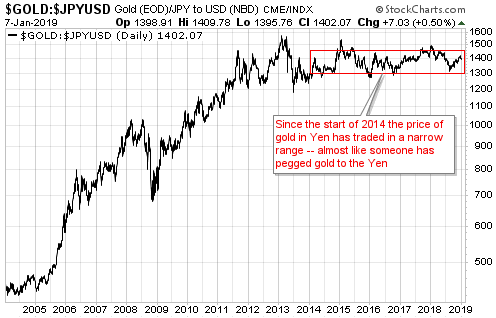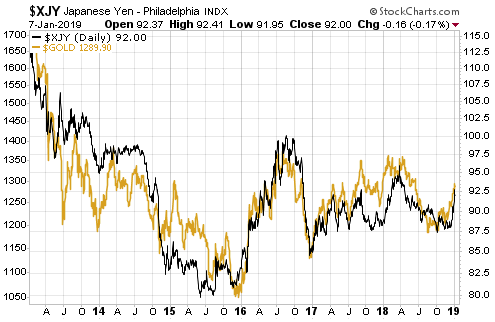About five months ago I posted an article in response to stories that the Chinese government had pegged either the SDR-denominated gold price or the Yuan-denominated gold price. These stories were based on gold’s narrow trading range relative to the currency in question over the preceding two years, as if government manipulation were the only or the most plausible explanation for a narrow trading range in a global market. To illustrate the silliness of these stories I came up with my own story — that it was actually the Japanese government that was pegging the gold price. My story had, and still has, the advantage of being a better fit with the price data.
Just to recap, my story was that the Japanese government took control of the gold market in early-2014 and subsequently kept the Yen-denominated gold price at 137,000 +/- 5%. They lost control in early-2015 and again in early-2018, but in both cases they quickly brought the market back into line.
The following chart shows that they remain in control.
The narrow sideways range of the Yen gold price over the past 5 years is due to the Yen being the major currency to which gold has been most strongly correlated. The correlation is positive, meaning that the prices of gold and the Yen have a strong tendency to trend in the same direction. This is evidenced by the following daily chart, which compares the US$ price of gold with the US$ price of the Yen.
Moving from the fantasy world to the real world, the relationship depicted above doesn’t exist because the Japanese government is pegging gold to the Yen. It exists because both gold and the Yen trade like safe havens, meaning that they tend to do relatively well when economic growth expectations and the general desire to take-on risk are on the decline, and relatively poorly when economic growth expectations and the general desire to take-on risk are on the rise.
Gold trades like a safe haven because in part that’s what it is. The Yen is a piece of crap, but it trades like a safe haven due to the relentless popularity of Yen carry trades. These carry trades involve borrowing/shorting the Yen to finance long positions in higher-yielding currencies, and are a form of yield-chasing speculation. Periodically they have to be exited in a hurry to mitigate the losses caused by declining prices in the aforementioned high-yielding speculations. When this happens the Yen rallies, and sometimes the rallies are dramatic. Last week, for example.
Divergences or non-confirmations between gold and the Yen can create trading opportunities. However, the two markets are in line with each other at the moment, meaning that there is currently no divergence or non-confirmation worth trading.
 Print This Post
Print This Post


